UKIAH, CA, 9/19/18 — It’s long been evident to cannabis farmers from the hills and valleys of the Emerald Triangle that if you plant some Bell Spring OG on a ridge near Albion, the flowers won’t turn out the same as if you plant it in a valley near Garberville. Whether it’s humidity or elevation, a particular mix of soil or the pruning method — there’s an undeniable difference.
For small farmers, whatever their crop, marking their product as distinct can have huge economic impact. And California’s cannabis farmers are no different. On the North Coast, cannabis farmers compare themselves to the neighboring vineyards, who highlight their unique “terroir” to court consumers. Now the California Department of Food & Agriculture is in the process of establishing a process for defining cannabis “appellations,” specific geographic areas in which farmers will be allowed to identify and market their crop with that name, such as Champagne. The agency kicked off a statewide appellations tour with their very first public meeting on the process in Ukiah on September 10. Local groups should be able to submit applications to create appellations by 2021.
Though cannabis growers, now venturing from decades of working underground into the cold light of the state’s new recreational market, are turning to other agricultural industries for survival strategies, and cannabis appellations are often compared to those used in wine, the statewide process may ultimately create very different standards.
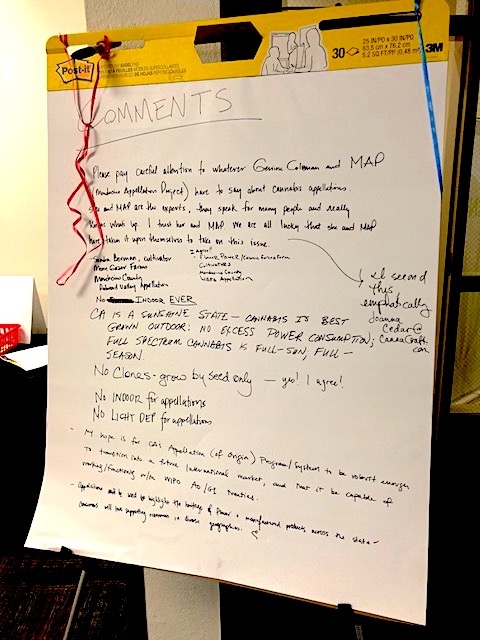
Handwritten comments at the CDFA cannabis public scoping session in Ukiah on Sept 10 — Kate B. Maxwell.
The CDFA is mandated to start establishing “county of origin” standards as of January 1, and must develop “a process by which licensed cultivators may establish appellations standards, practices, and varietals applicable to cannabis grown in a certain geographical area in California” by 2021. This process was legislated by SB 94, proposed by the North Coast’s State Senator Mike McGuire and passed as part of a trailer bill in 2017. However, the legislation does not provide much detail as to what the exact process will look like. So to begin creating a regulatory framework, the CDFA conducted a survey of cultivators, and is soliciting feedback from cannabis growers at “public scoping sessions” about what they think the applications process for new appellations should look like.
“The statute is very brief,” noted CDFA’s spokesperson Rebecca Foree in an interview. “We’re starting from a blank slate — we’re waiting to get input before we establish the regulations and fill out the framework.” She emphasized that regulators hoped to design the appellations process based on input from stakeholders, and said the agency has already received “a tremendous amount of feedback,” especially from farmers on the North Coast. CalCannabis, the CDFA department that oversees cannabis cultivation licensing, is accepting comments through the end of September, and then will hold another round of public workshops, planned for early 2019. The department will then conduct economic impact studies and draft regulations. By 2021, cultivators should be able to submit appellations proposals for approval.
The Mendocino Appellations Project, which began in 2015, is coordinating with other groups to get farmers thinking about how to codify what makes their crop unique: the types of standards, traditional growing practices, and particular microclimates and varietals that define a particular place. To highlight the importance of these regulations for multi-generational “legacy farmers” to state regulators, MAP is also organizing a “No Region Left Behind” rally on the Capitol building steps in Sacramento on September 19, prior to the CDFA’s scoping session that afternoon.
Ukiah Meeting
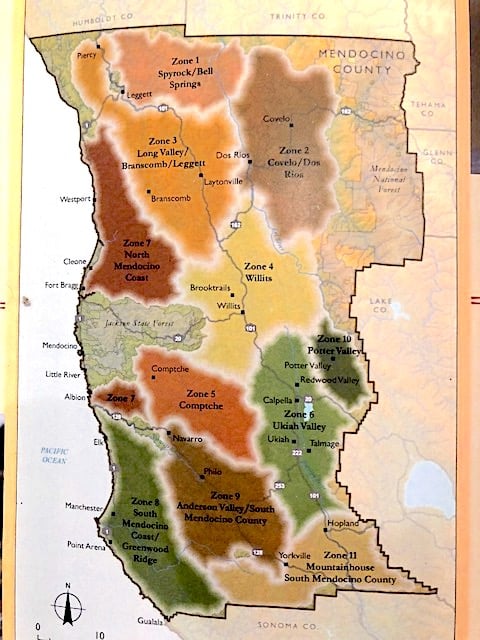
Mendocino Appellations Project outreach map.
At a luncheon in Ukiah before the first CDFA meeting, Genine Coleman, Executive Director of the Mendocino Appellations Project (MAP), spoke to about 30 Mendocino and Humboldt cannabis farmers. Coleman began by saying that many regional farmers are struggling in the current state market, but that cannabis appellations in California could set a precedent nationwide. MAP has outlined 11 potential appellations districts for Mendocino County by conducting research alongside farmers, such as Bell Springs-Spyrock, Potter Valley, and Round Valley-Dos Rios through a series of outreach events, including appellations-focused farm-to-table cannabis dinners.
According to Coleman, appellations designations could develop a craft cannabis market allowing small farmers to be “price-makers,” and boost the broader economy through agri-tourism. She also claimed that appellations would increased safety standards for consumers and cannabis patients. Currently, only cannabis grown within a particularly California county can be marketed with that name, but appellations could provide stricter standards, or even production caps for certain varietals.
Coleman encouraged farmers to think about how to embody the qualities of their current practices in a set of community standards. Local groups will be able to submit applications to establish regulations, but there will be “a lot of work that needs to happen on the ground,” she noted, telling the crowd, “it’s your standards, it’s your practices, it’s your cultivars and your intellectual property.”
The regulatory system established by CDFA, whatever it may be, may also provide an enforcement mechanism for appellations products, potentially through the “track and trace” system. Currently, both Mendocino and Humboldt counties have contracted with the company SICPA for the county-wide system of “track and trace” required by state law, which allows for a “proof of origin” certification. However, the state has currently contracted with a different software provider, METRC, does not.
The Details
“There’s really no comparison” with American vineyard designations, Coleman said, and she encouraged cultivators to pursue the more stringent requirements for internationally recognized “appellations of origin,” which include those in the Champagne region of France. “American Viticultural Areas,” which comprise the majority of the wine-based appellations in the United States, require 85% of the grapes to be grown in a particular location and finished in the state. In comparison, geographic labelling for cannabis requires 100% of cannabis in the product to be produced in a particular California county to receive a “county of origin” certification, or to use the county name on labelling. Whether cannabis manufacturers will be eligible for appellations designations also remains to be seen.
MAP has made specific requests to the CDFA, including: creating a tiered system of geographic-based appellations; requiring cannabis certified within appellations to be exclusively sun-grown and planted in the grown; and to allow the creation of regional standards. MAP organizers emphasized that appellations standards could incentivize environmentally-sustainable growing methods, as well as help preserve the region’s heritage of cannabis growing in the face of a rapidly changing and industrializing industry. The emphasis on cannabis planted in the ground and without supplemental light should allow farmers to better illustrate their unique “terroir,” and differentiate their crops. The group is also requesting the creation of the creation of statewide or regional cannabis cultivar libraries.
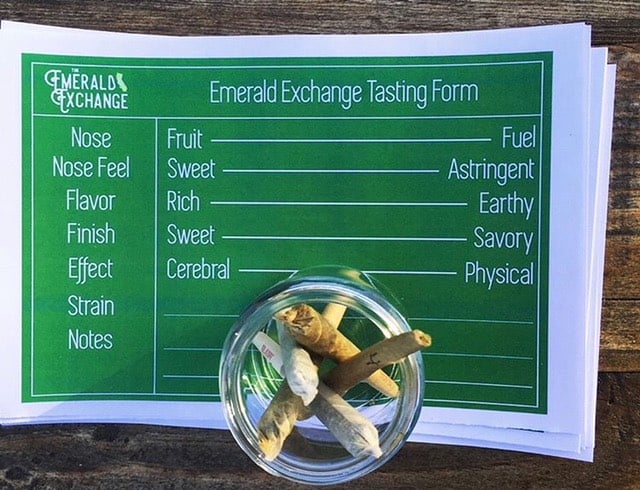
Cannabis tasting form from the MAP appellations farm-to-table dinner in Ukiah in 2017 — Kate B. Maxwell.
MAP is working with oral history researchers and research scientists, including the 420 Archive, to begin to catalog local libraries of strains, and historic growing practices, as part of the larger appellations framework. The organization is also establishing a series of weather stations at cannabis farms so growers can track their unique microclimates and delineate the boundaries future appellation proposals. Swami Chaitanya, a MAP board member, highlighted the need for more research, adding that many local farmers are still figuring out what strains do best in what areas.
MAP is also working with the Mendocino Cannabis Industry Association, the Mendocino County and Humboldt County Growers Alliances, and the International Cannabis Farmers Association to encourage cultivators to engage with the regulatory process, and submit unified feedback to CalCannabis. Coleman noted that in Mendocino County, many farmers have defined their communities through “community hubs” like nearby towns or boundaries such as fire protection districts, whereas in Humboldt the appellations movement has focused more on watersheds as delineating origins.
Upcoming challenges
One potential pitfall for the appellations process is ensuring that producers using the labels are following the established requirements — something that can be an issue in the wine industry. During the MAP lunch, Coleman and others noted that neighboring farmers, who will be establishing the appellations requirements, will have an economic interest in “self-policing” to ensure the label isn’t being abused to protect the value of their own crops. Justin Calvino, who originally founded MAP in 2015, added, “hopefully this gets the largest group of farmers off their land and into a room at least one day a month,” proposing that Wall Street bankers might begin to seek out their “Talmage Kush,” if the craft cannabis market is better established.
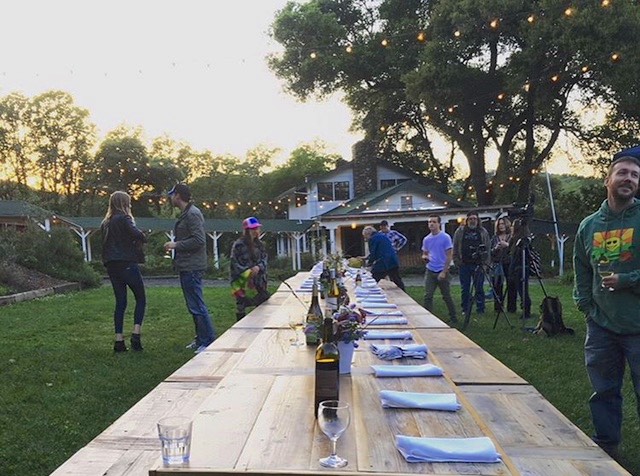
MAP appellations farm to table dinner at Yokayo Ranch, April 2017.
Several growers pointed to need to highlight a history of “innovative pioneers” to distinguish their brand in the market, and a discussion ensued of how to best communicate that history via succinct labelling to consumers or retailers, who may be currently more interested in potency levels or price points. Many hoped appellations would create an appreciation of their craft for consumers that would also help their farms — and broader communities — survive the high barriers created by the new regulations.
Information about submitting comments to CalCannabis can be found in the PDF below. The agency will be holding additional meetings around the state in September in Sacramento, Palm Desert, Lompoc, and Monterey.
Appellations Fact Sheet_9.5.18
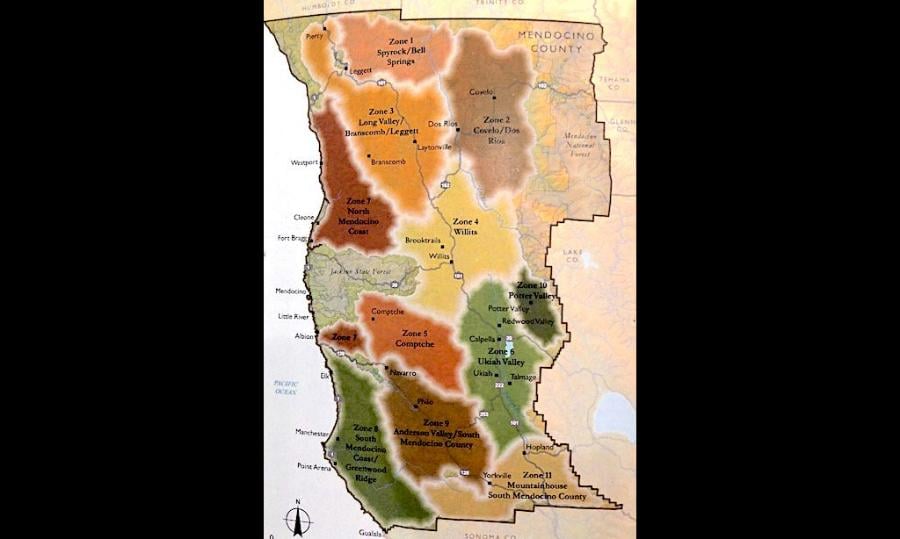



Saw that one coming. The very municipalities who destroyed canna-folks lives in the past – now want to cash in. ‘Merica!!!